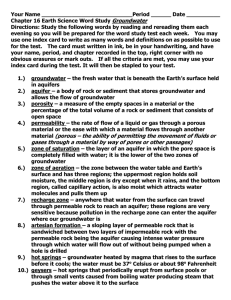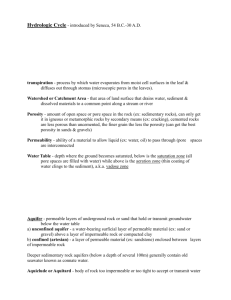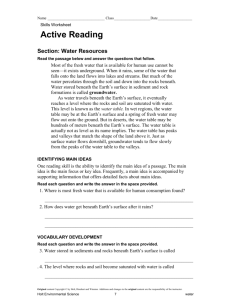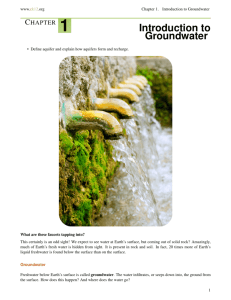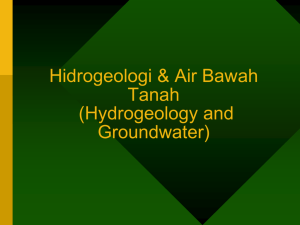Water Underground Worksheet: Groundwater & Aquifers
advertisement
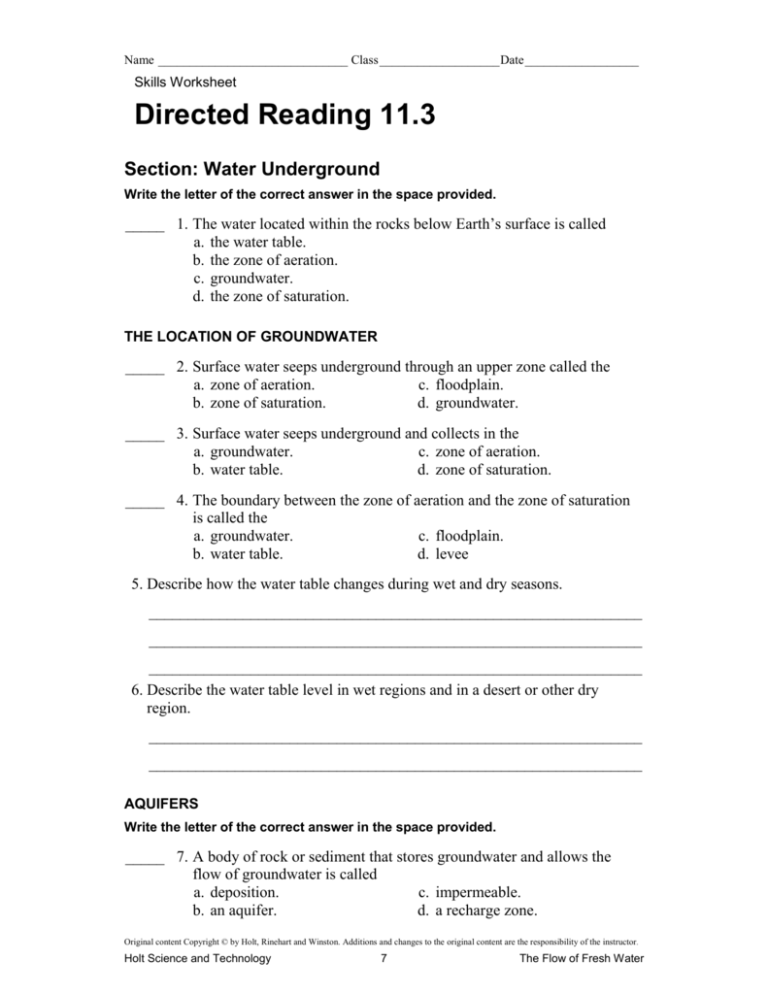
Name ______________________________ Class ___________________ Date __________________ Skills Worksheet Directed Reading 11.3 Section: Water Underground Write the letter of the correct answer in the space provided. _____ 1. The water located within the rocks below Earth’s surface is called a. the water table. b. the zone of aeration. c. groundwater. d. the zone of saturation. THE LOCATION OF GROUNDWATER _____ 2. Surface water seeps underground through an upper zone called the a. zone of aeration. c. floodplain. b. zone of saturation. d. groundwater. _____ 3. Surface water seeps underground and collects in the a. groundwater. c. zone of aeration. b. water table. d. zone of saturation. _____ 4. The boundary between the zone of aeration and the zone of saturation is called the a. groundwater. c. floodplain. b. water table. d. levee 5. Describe how the water table changes during wet and dry seasons. _______________________________________________________________ _______________________________________________________________ _______________________________________________________________ 6. Describe the water table level in wet regions and in a desert or other dry region. _______________________________________________________________ _______________________________________________________________ AQUIFERS Write the letter of the correct answer in the space provided. _____ 7. A body of rock or sediment that stores groundwater and allows the flow of groundwater is called a. deposition. c. impermeable. b. an aquifer. d. a recharge zone. Original content Copyright © by Holt, Rinehart and Winston. Additions and changes to the original content are the responsibility of the instructor. Holt Science and Technology 7 The Flow of Fresh Water Name ______________________________ Class ___________________ Date __________________ Directed Reading A continued ____ 8.What is a name for the percentage of the total volume of a rock or sediment that consists of open spaces? a. permeability c. porosity b. gradient d. recharge zone _____ 9. What do we call the ability of a rock or sediment to let fluids pass through its open spaces, or pores? a. deposition c. porosity b. gradient d. permeability _____ 10. Rock that is able to stop the flow of water is called a. impermeable. c. recharged. b. permeable. d. an aquifer. _____ 11. What is the name of a force that causes moving objects to slow down? a. permeability c. porosity b. friction d. deposition _____ 12. An area in which water travels downward to become part of an aquifer is the a. recharge zone. c. rehydration zone. b. relief zone. d. refresh zone. 13. Why does a rock layer with many particles of different sizes have low porosity? _______________________________________________________________ _______________________________________________________________ _______________________________________________________________ _______________________________________________________________ _______________________________________________________________ 14. Why does a rock layer containing same-sized particles have high porosity? _______________________________________________________________ _______________________________________________________________ _______________________________________________________________ _______________________________________________________________ _______________________________________________________________ Original content Copyright © by Holt, Rinehart and Winston. Additions and changes to the original content are the responsibility of the instructor. Holt Science and Technology 8 The Flow of Fresh Water Name ______________________________ Class ___________________ Date __________________ Directed Reading A continued 15. Why do large particles in a rock layer cause less friction than small particles? _______________________________________________________________ _______________________________________________________________ 16. How does a layer of impermeable rock or a building affect a recharge zone? _______________________________________________________________ SPRINGS AND WELLS Write the letter of the correct answer in the space provided. _____ 17. The tendency to move downslope, toward lower elevations, is a characteristic of a. zones. c. tables. b. water. d. plains. _____ 18. If the water table reaches the Earth’s surface, water flows up from the ground, forming a a. river. c. lake. b. plain. d. spring. _____ 19. What body of groundwater will form in a place where the water table is higher than the Earth’s surface? a. a lake c. a spring b. a river d. a well 20. A sloping layer of permeable rock between two layers of impermeable rock is a(n) ______________________. 21. A crack in the cap rock of the aquifer allows the water to flow from a(n) ______________________. 22. Why do some springs have hot water? _______________________________________________________________ _______________________________________________________________ 23. A human-made hole deeper than the level of the water table is a______________________. 24. What happens to the water table if too many wells are built and groundwater is removed too rapidly? _______________________________________________________________ _______________________________________________________________ Original content Copyright © by Holt, Rinehart and Winston. Additions and changes to the original content are the responsibility of the instructor. Holt Science and Technology 9 The Flow of Fresh Water Name ______________________________ Class ___________________ Date __________________ Directed Reading A continued 25. How does groundwater cause erosion? _______________________________________________________________ _______________________________________________________________ UNDERGROUND EROSION AND DEPOSITION 26. Describe how caves are formed. _______________________________________________________________ _______________________________________________________________ Match the correct description with the correct term. Write the letter in the space provided. _____ 27. sharp, icicle-shaped feature formed by calcium carbonate on cave ceilings a. stalagmite _____ 28. cone-shaped feature formed when water drips to a cave’s floor c. sinkhole b. dripstone column d. stalactite _____ 29. a stalagmite and stalactite that have joined together _____ 30. a circular depression that results when the roof of a cave collapses 31. Describe the process by which a sinkhole is formed. _______________________________________________________________ _______________________________________________________________ _______________________________________________________________ Original content Copyright © by Holt, Rinehart and Winston. Additions and changes to the original content are the responsibility of the instructor. Holt Science and Technology 10 The Flow of Fresh Water

